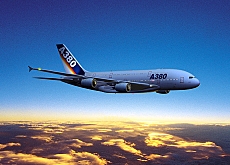
Swiss technology keeps an eye on A380 engines

The new European Airbus A380 has taken to the skies with some sophisticated Swiss equipment keeping an eye on the performance of its engines.
vibro-meter based in Fribourg in western Switzerland has supplied a system that provides a detailed image of engine condition.
It is designed to give vital data about the “health” of the engines, as well as saving maintenance costs.
vibro-meter is supplying the so-called Engine Monitoring Unit, which is installed on each of the A380’s four engines.
The electronic box will collect and process various engine parameters including vibration signals, rotational speeds, pressures, temperatures and oil debris information.
Safety and maintenance
“It measures a whole bunch of parameters from the engine for two purposes. One is safety, to indicate those parameters to the pilot so that he can act on them, and the second is maintenance planning,” company general manager Peter Huber told swissinfo.
“By running a lot of those parameters through sophisticated algorithms, you can actually reduce your maintenance costs and you can get to a stage where you actually only replace those parts that need replacing.”
Huber explained that the best way to understand was to imagine the engine as a system of rotating parts.
“Damage to any of these parts will result in an out-of-balance of the system and will produce vibration similar to what you would see on your car when your wheel goes out of balance and it starts to wobble about.”
There are two end users of the monitoring unit. “One is the guy in the cockpit. He needs the information to make decisions,” Huber explained.
“The other end users are the people doing maintenance. That can be a company like SR Technics or Lufthansa Technics, which will take that information and act on it accordingly,” he added.
Advance diagnosis
In other words, if early signs of deterioration in efficiency or operation condition are detected, the possible fault can be diagnosed in advance and the appropriate corrective action planned.
The unit cost about SFr10 million ($8.36 million) to develop and contains a lot of new complex software. And it has to withstand an unfriendly environment.
“The temperature range where this box has to operate goes from about minus 54 degrees Celsius to about plus 120, so it’s a bit more sophisticated than your PC at home. That wouldn’t do the job,” Huber said.
The unit is expected to provide vibro-meter with sustainable additional sales of about SFr3-5 million per year over the life of the aircraft production, which is about 20 years.
“But the more important dimension for us is the strategic dimension because this unit now on the A380 is the first of its kind,” Huber added.
Good position
“We are also in discussions with Boeing on the new 787. The architecture will be the same, so we are in a good position to go after business in all the new aircraft that are going to be developed over the next ten to 20 years,” Huber explained.
“We are actually in discussions with Rolls-Royce, General Electric and Boeing with regards to providing the Engine Monitoring Unit on the 787,” he added.
Since its foundation in 1954, vibro-meter has been a specialist in sensors allowing precision measurement of mechanical values such as pressure, torque, vibration and displacement.
In the early days, an important customer was Brown Boveri (now ABB), with vibro-meter sensors measuring parameters on industrial equipment such as gas turbines.
The move into the aviation industry in the 1960s and 70s came about because of two main events.
One was when company engineers could help find an innovative solution to a problem Swissair had with its Coronado aircraft.
Formula 1
Contacts the company had with Formula 1 motor racer Jo Siffert, a Swiss who was born in Fribourg, led the company into testing of engines.
“You can even see on some of the old pictures of Jo Siffert that the name “vibro-meter” is featured on his car.
“That gave contacts into Britain and eventually into the aircraft division of Rolls Royce. That started us off in the aviation business,” Huber said.
The company now designs and manufactures sensors, electronics and software for demanding high-tech markets – aviation, space, industrial and marine.
And its future growth under the wing of Britain’s Meggitt group looks rather rosy, with management believing that it can double sales within the next ten to 15 years.
“I’m very positive for the future because we have a very strong position technically now… We are on all the civil aircraft that are being produced at the moment, ” Huber told swissinfo.
Despite heavy competition from the US, it looks like having a strong parent is good news in an aviation industry that has been consolidating.
“We’re technically really state-of-the-art with that equipment. I think our owner provides us with financial clout that allows us to buy others, rather than being bought by others,” Huber added.
swissinfo, Robert Brookes in Fribourg
The A380 is the world’s largest passenger jet.
It is a four-aisle, four-engine, double-decker “superjumbo”.
In a standard three-class cabin configuration, the A380 will carry 555 passengers.
The A380 is due to enter airline service in 2006.
Apart from vibro-meter, several other Swiss companies are contributing to the Airbus A380, including:
RUAG Aerospace – outer fixed trailing edge of the wing;
Liebherr – control system to drive the wing flaps;
Leica Geosystems – its laser trackers are used in the section assembly of body parts;
Alu Menziken – cleats for the wings.
Lantal Textiles – aircraft seat covers.

In compliance with the JTI standards
More: SWI swissinfo.ch certified by the Journalism Trust Initiative




























You can find an overview of ongoing debates with our journalists here . Please join us!
If you want to start a conversation about a topic raised in this article or want to report factual errors, email us at english@swissinfo.ch.